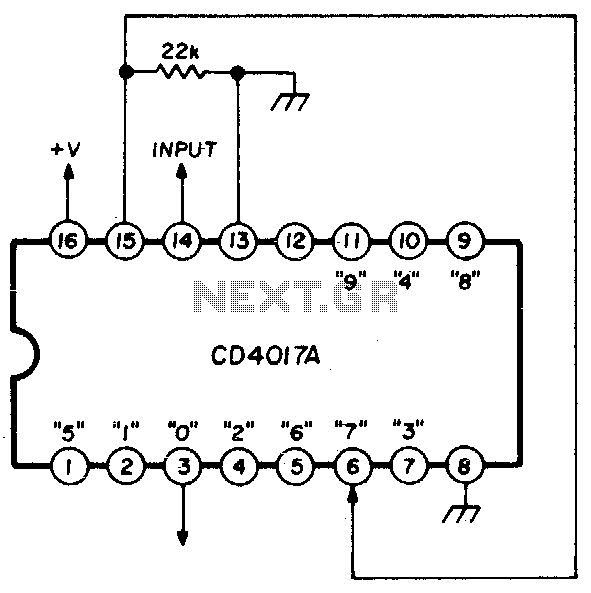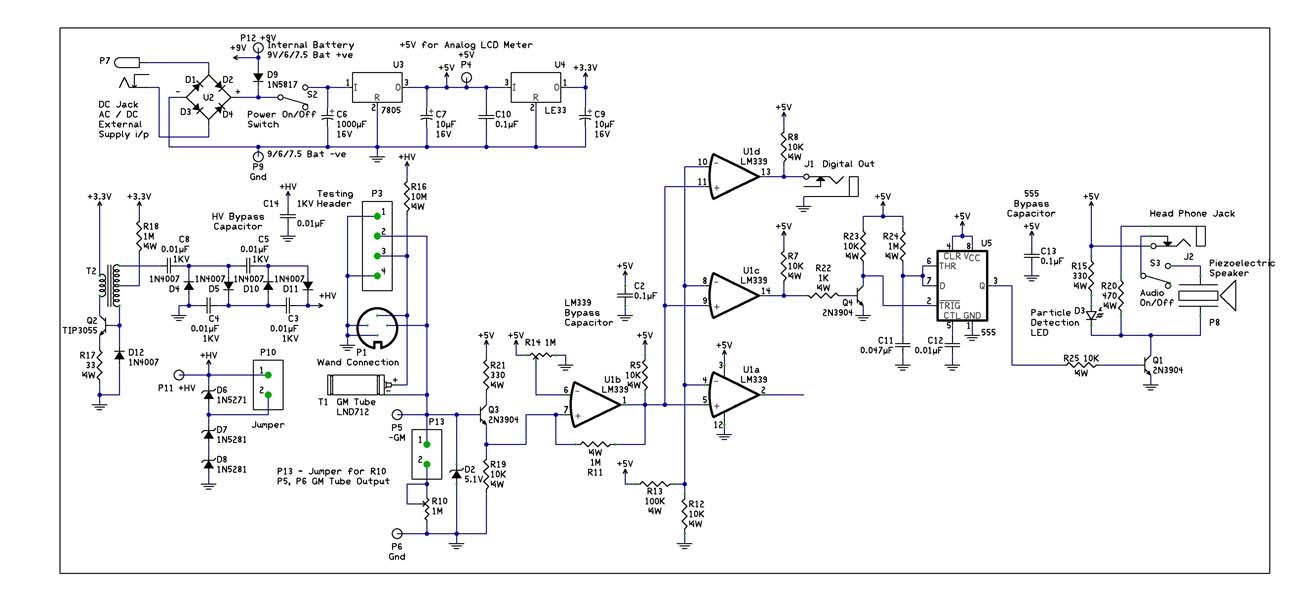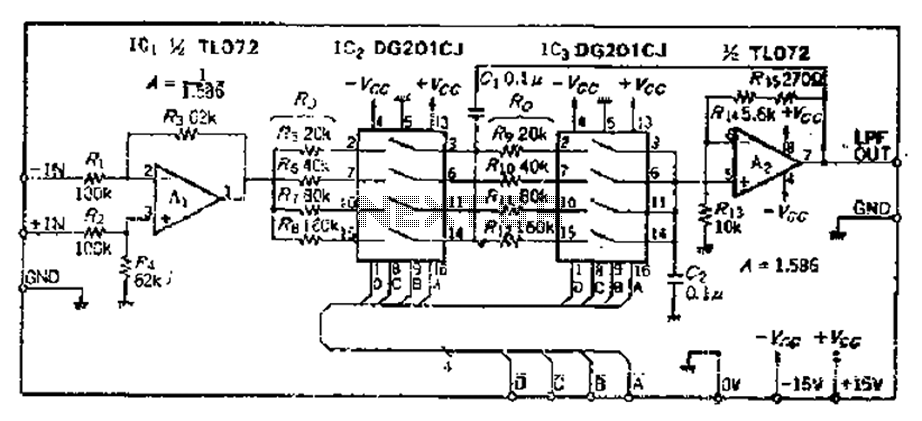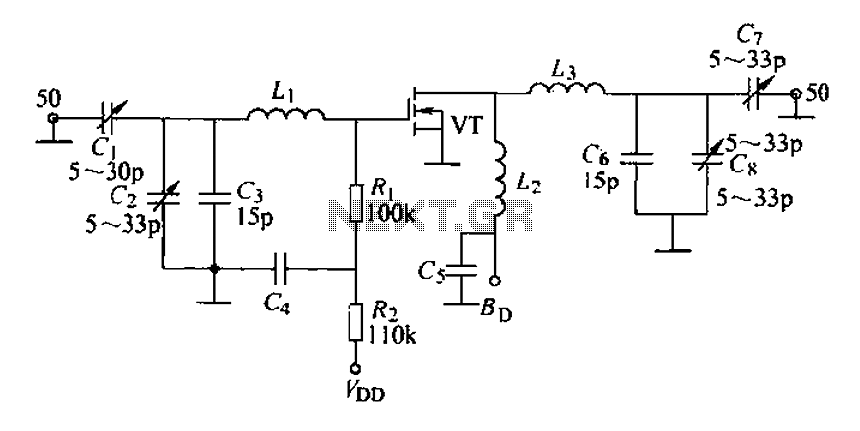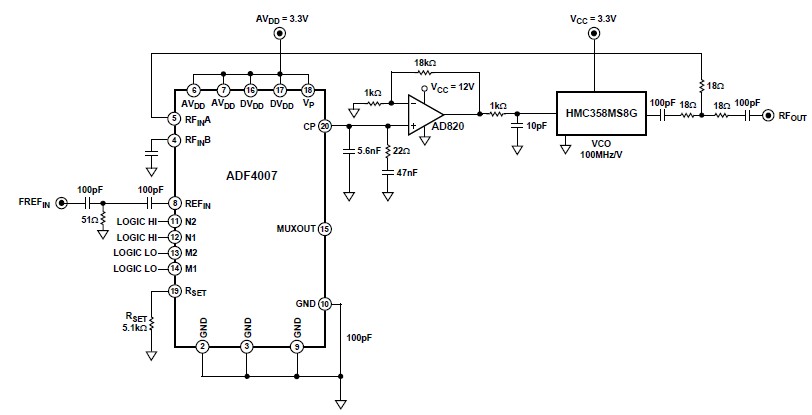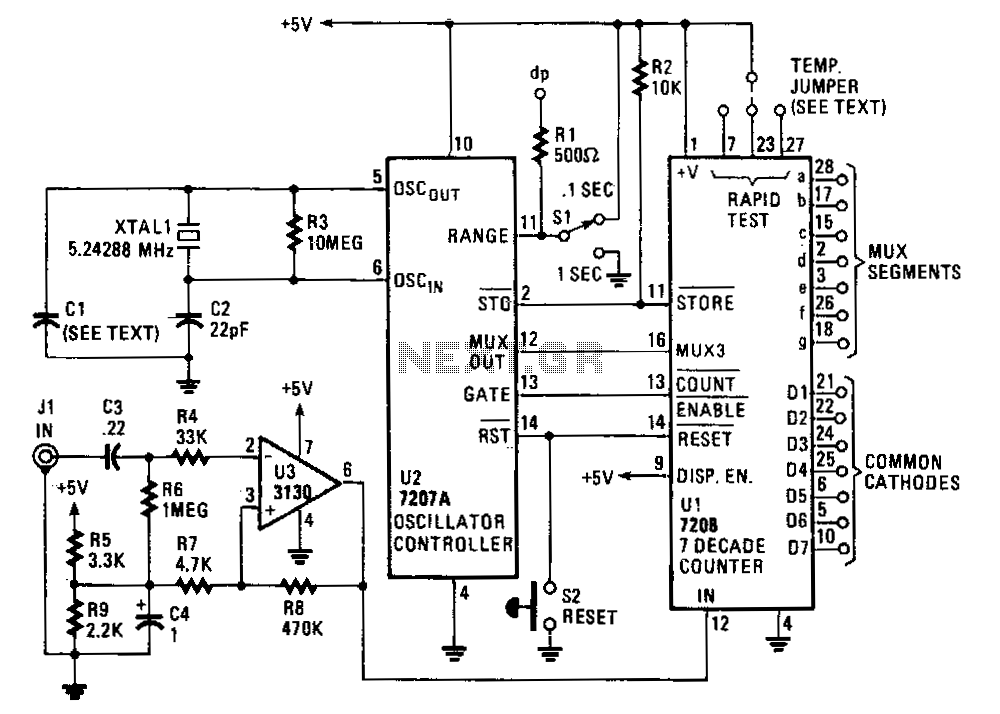
13 GHz Frequency Counter Prescaler
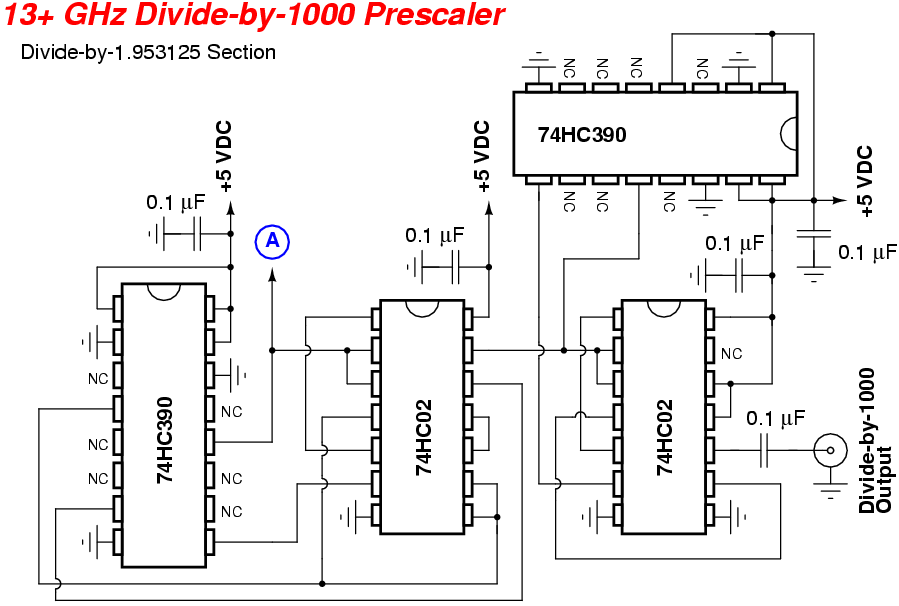
A straightforward "divide-by-1000" circuit was originally designed by Zeljko Bozic, S52ZB, in a 2006 issue of VHF Communications Magazine. This project aims to extend the range of older and more affordable frequency counters. Frequency counters capable of measuring up to 100 MHz can often be purchased for around $20 at hamfests or eBay, and this simple circuit can enhance their range to at least 13 GHz. The design incorporates a Hittite HMC363 divide-by-8 prescaler, a Fujitsu MB506 divide-by-64 prescaler, and a "divide-by-1.953125" circuit using standard digital logic. The Hittite HMC363 prescaler can operate effectively up to approximately 13 GHz, and with increased input RF power and minimized exposure time, it can reach 15 GHz. The HMC363 evaluation board is available for about $100, or it may be possible to obtain a couple of HMC363 units as free samples. This evaluation board is ideal for high-frequency microwave applications due to its proper design. The Fujitsu MB506 is found in some MMDS or satellite TV downconverters, and the Fujitsu MB501 can be substituted with minor circuit modifications. Fujitsu MB501 prescalers are also present in older analog cellular phones. The remaining circuit features a simple ECL-to-CMOS logic converter utilizing a Maxim MAX961 high-speed comparator, alongside 74HC390 ripple counters and 74HC02 NOR-gate logic chips configured as a divider. The output from the Fujitsu MB506 is in Emitter-Coupled Logic (ECL), presenting a signal of 1.6 volts peak-to-peak with a DC offset of approximately 3 volts. The Maxim MAX961 compares this ECL signal to a predetermined reference DC voltage, converting it to a standard +5/0 volts signal. The "divide-by-1.953125" configuration is achieved by employing three "divide-by-1.25" circuits, effectively resulting in the desired division (1.25 x 1.25 x 1.25 = 1.953125). Non-integer division is accomplished by selectively removing certain pulses in the divider chain. The Hittite HMC363 evaluation board is centrally located within the design, while an old California Amplifier downconverter case (upper-right) houses the remaining digital logic. RF input and prescaler output are connected via panel-mount N and BNC connectors. The circuit is powered through eight "AA" batteries (+12 VDC) housed in a standard holder available from Radio Shack. The +12 VDC is fed into the 78L05 voltage regulator through a 1000 pF feed-through capacitor located at the upper-left. Another feed-through capacitor supplies a clean +5 VDC source for the Hittite HMC363 evaluation board. The Fujitsu MB506 prescaler is situated in the middle-left, connected via a BNC jack to the downconverter case. The 8-pin SMT component located at the lower-right of the MB506 is the Maxim MAX961 comparator. On the right side are the two 74HC390 ripple counters and the 74HC02 two-input NOR gates. The maximum input to the Fujitsu MB506 prescaler is around 1.6 GHz, necessitating the use of proper microwave construction techniques for that IC, while other components can manage standard low-frequency signals. High-quality conformable coax is recommended for the HMC363's RF input to support frequencies above 10 GHz, while standard RG-58 or equivalent cables can be used for lower frequency signals. It is advisable to utilize high-quality coax and connectors throughout the project to minimize signal leakage and interference from external RF signals. The frequency counter displays "10.51124 MHz" for a final RF input frequency of 10.51124 GHz, sourced from a Gunn diode in a stock MPH Industries K55 X-band police radar with a WR-90 to N adapter. The output from this Gunn diode source is approximately +14 dBm (25 mW), necessitating the addition of a 10 dB attenuator at the input to the prescaler to reduce the signal level.
This circuit serves as a valuable tool for amateur radio enthusiasts and professionals seeking to enhance the capabilities of older frequency counters. The integration of high-frequency prescalers and digital logic components allows for precise frequency measurements in the microwave range, extending the utility of budget-friendly equipment. The careful selection of components, along with adherence to proper construction practices, ensures reliable performance and accuracy in frequency division applications. The design exemplifies the innovative spirit of the amateur radio community, providing an accessible solution for those looking to expand their measurement capabilities without the need for expensive, high-end frequency counters.A fairly simple "divide-by-1000" circuit which was first designed by Zeljko Bozic, S52ZB, in a 2006 issue of VHF Communications Magazine. The idea of this project is to extend the range of older (and cheaper) frequency counters. You can often find 100 MHz frequency counters for as little as $20 at hamfests or eBay, and this simple circuit wi
ll extend their range up to at least 13 GHz. This version is based around a Hittite HMC363 divide-by-8 prescaler, a Fujitsu MB506 divide-by-64 prescaler, and a "divide-by-1. 953125" circuit using standard digital logic. The Hittite HMC363 front-end prescaler is good up to 13 GHz or so, and will do 15 GHz if you increase the input RF power a bit and minimize the prescaler`s exposure time.
It`s possible to pick up the Hittite HMC363 evaluation board for around $100, or you may be able to receive a couple HMC363s as free samples. The evaluation board will be ideal, as it`s properly designed for high-frequency microwave work. The Fujitsu MB506 can be found in some MMDS or satellite TV downconverters, the Fujitsu MB501 can probably be substituted with a slight circuit change.
Fujitsu MB501 prescalers can be found in older analog cellular phones. The rest of the circuit is just a simple ECL-to-CMOS logic converter using a Maxim MAX961 high-speed comparator, and some 74HC390 ripple-counters and 74HC02 NOR-gate logic chips wired up as a divider. The output of the Fujitsu MB506 is in Emitter-Coupled Logic (ECL), which means the signal is 1. 6 volts peak-to-peak with a DC offset of around 3 volts. The Maxim MAX961 compares this signal to a preset reference DC voltage and converts the signal into one with the normal +5/0 volts that we`re used to.
The "divide-by-1. 953125" circuit is based around the fact that by using three "divide-by-1. 25" circuits you can effectivly divide by 1. 953125 (1. 25 x 1. 25 x 1. 25 = 1. 953125). Dividing by non-whole numbers comes about by removing certain pulses in the divider chain. The Hittite HMC363 evaluation board is in the middle, an old California Amplifier downconverter case (upper-right) will hold the rest of the digital logic. Panel-mount N and BNC connectors will be for the RF input and prescaler output. The circuit will be powered via eight "AA" batteries (+12 VDC) in a standard holder available at Radio Shack.
The +12 VDC comes in to the 78L05 voltage regulator via the 1000 pF feed-through capacitor on the upper-left. The other feed-through capacitor provides a clean +5 VDC source to supply the Hittite HMC363 evaluation board.
In the middle-left, is the Fujitsu MB506 prescaler fed via a BNC jack attached to the downconverter case. The 8-pin SMT part to the lower-right of the MB506 is the Maxim MAX961 comparator. On the right-side are the two 74HC390 ripple-counters and 74HC02 two-input NOR gates. The maximum input to the Fujitsu MB506 prescaler will be around 1. 6 GHz, so proper microwave construction techniques will need to be used for that IC. Everything else can be handled as regular low-frequency signals. High-quality conformable coax is used on the HMC363`s RF input due to its better support for frequencies above 10 GHz.
The rest of the RF cables can be standard RG-58, or equivalent, as they will be carrying lower frequency signals. Do try to use high-quality coax and connectors throughout this project to avoid signal leakage or receiving external RF signals.
The frequency counter is reading "10. 51124 MHz" for a final RF input frequency of 10. 51124 GHz. This signal was a Gunn diode source from a stock MPH Industries K55 X-band police radar with a WR-90 to N adapter. The output from this Gunn diode source is around +14 dBm (25 mW), so a 10 dB attenuator was added to the input of the prescaler to knock the signal down a bit.
🔗 External reference
This circuit serves as a valuable tool for amateur radio enthusiasts and professionals seeking to enhance the capabilities of older frequency counters. The integration of high-frequency prescalers and digital logic components allows for precise frequency measurements in the microwave range, extending the utility of budget-friendly equipment. The careful selection of components, along with adherence to proper construction practices, ensures reliable performance and accuracy in frequency division applications. The design exemplifies the innovative spirit of the amateur radio community, providing an accessible solution for those looking to expand their measurement capabilities without the need for expensive, high-end frequency counters.A fairly simple "divide-by-1000" circuit which was first designed by Zeljko Bozic, S52ZB, in a 2006 issue of VHF Communications Magazine. The idea of this project is to extend the range of older (and cheaper) frequency counters. You can often find 100 MHz frequency counters for as little as $20 at hamfests or eBay, and this simple circuit wi
ll extend their range up to at least 13 GHz. This version is based around a Hittite HMC363 divide-by-8 prescaler, a Fujitsu MB506 divide-by-64 prescaler, and a "divide-by-1. 953125" circuit using standard digital logic. The Hittite HMC363 front-end prescaler is good up to 13 GHz or so, and will do 15 GHz if you increase the input RF power a bit and minimize the prescaler`s exposure time.
It`s possible to pick up the Hittite HMC363 evaluation board for around $100, or you may be able to receive a couple HMC363s as free samples. The evaluation board will be ideal, as it`s properly designed for high-frequency microwave work. The Fujitsu MB506 can be found in some MMDS or satellite TV downconverters, the Fujitsu MB501 can probably be substituted with a slight circuit change.
Fujitsu MB501 prescalers can be found in older analog cellular phones. The rest of the circuit is just a simple ECL-to-CMOS logic converter using a Maxim MAX961 high-speed comparator, and some 74HC390 ripple-counters and 74HC02 NOR-gate logic chips wired up as a divider. The output of the Fujitsu MB506 is in Emitter-Coupled Logic (ECL), which means the signal is 1. 6 volts peak-to-peak with a DC offset of around 3 volts. The Maxim MAX961 compares this signal to a preset reference DC voltage and converts the signal into one with the normal +5/0 volts that we`re used to.
The "divide-by-1. 953125" circuit is based around the fact that by using three "divide-by-1. 25" circuits you can effectivly divide by 1. 953125 (1. 25 x 1. 25 x 1. 25 = 1. 953125). Dividing by non-whole numbers comes about by removing certain pulses in the divider chain. The Hittite HMC363 evaluation board is in the middle, an old California Amplifier downconverter case (upper-right) will hold the rest of the digital logic. Panel-mount N and BNC connectors will be for the RF input and prescaler output. The circuit will be powered via eight "AA" batteries (+12 VDC) in a standard holder available at Radio Shack.
The +12 VDC comes in to the 78L05 voltage regulator via the 1000 pF feed-through capacitor on the upper-left. The other feed-through capacitor provides a clean +5 VDC source to supply the Hittite HMC363 evaluation board.
In the middle-left, is the Fujitsu MB506 prescaler fed via a BNC jack attached to the downconverter case. The 8-pin SMT part to the lower-right of the MB506 is the Maxim MAX961 comparator. On the right-side are the two 74HC390 ripple-counters and 74HC02 two-input NOR gates. The maximum input to the Fujitsu MB506 prescaler will be around 1. 6 GHz, so proper microwave construction techniques will need to be used for that IC. Everything else can be handled as regular low-frequency signals. High-quality conformable coax is used on the HMC363`s RF input due to its better support for frequencies above 10 GHz.
The rest of the RF cables can be standard RG-58, or equivalent, as they will be carrying lower frequency signals. Do try to use high-quality coax and connectors throughout this project to avoid signal leakage or receiving external RF signals.
The frequency counter is reading "10. 51124 MHz" for a final RF input frequency of 10. 51124 GHz. This signal was a Gunn diode source from a stock MPH Industries K55 X-band police radar with a WR-90 to N adapter. The output from this Gunn diode source is around +14 dBm (25 mW), so a 10 dB attenuator was added to the input of the prescaler to knock the signal down a bit.
🔗 External reference
